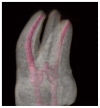In vitro evaluation of carrier based obturation technique: a CBCT study
- PMID: 27486506
- PMCID: PMC4955918
- DOI: 10.11138/ads/2016.7.1.011
In vitro evaluation of carrier based obturation technique: a CBCT study
Abstract
Aim: The goal of the study was to compare the ability of two different carrier based obturation (CBO) techniques to reach working length and fill in three-dimensions root canal systems, by using CBCT.
Materials and methods: Twenty-six extracted molars were scanned with CBCT and 40 curved canals were selected (between 30° and 90°) and divided in two similar groups (n=20). All canals were prepared up to size 25 taper .06 using nickel-titanium instrumentation. The canals in the Group SC were obturated using Soft-Core obturators (Kerr, Romulus, Mi, USA), while Group TH canals (n= 20) were obturated using Thermafil Endodontic Obturators (Tulsa Dental Products, Tulsa, OK, USA), strictly following manufacturers' instructions for use. The obturations were analyzed by means of CBCT to measure the distance from the apical limit of obturation to the apical foramen and the presence of voids inside root canals.
Results: There was no significant difference between the two groups in the mean distance of the apical extent of the obturation (t test, p>0.05). Overfilling occurred in only 3 cases (2 in Group TH and 1 in Group SC). The percentages of voids in both groups were very low with no significant difference (Z test, p>0.05).
Conclusions: The two tested CBO techniques showed similar positive results in terms of performance, even if, after checking with verifiers, in most cases the size of the selected Soft-Core obturator was one size smaller than Thermafil.
Keywords: Cone-beam Computed Tomography; Soft-Core; Thermafil; endodontic obturation.
Figures




References
-
- Johnson WT, Kulild JC. Obturation of the cleaned and shaped root canal system. In: Hargreaves KM, Cohen S, editors. Cohen’s Pathways of the Pulp. 10th edition. Mosby; St. Louis, Mo, USA: 2010. pp. 349–351.
-
- Schilder H. Filling root canals in three dimensions. Dental Clinics of North America. 1967;11:723–744. - PubMed
-
- Endodontics JOB, Report W. A New Gutta-Percha Technique. 1978;4(6) - PubMed
LinkOut - more resources
Full Text Sources
Other Literature Sources
